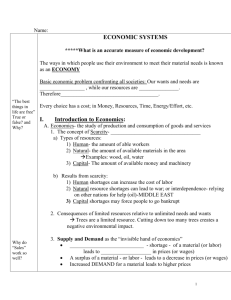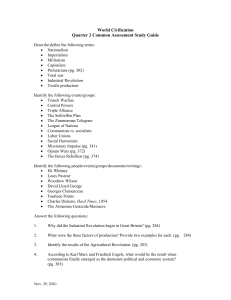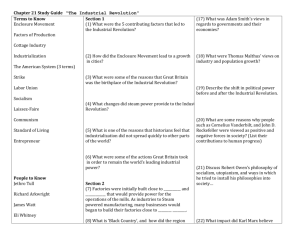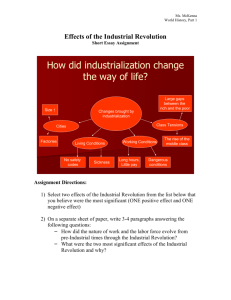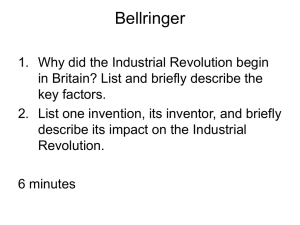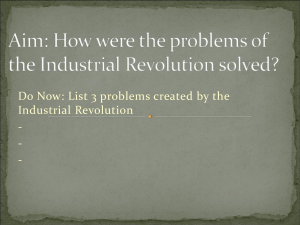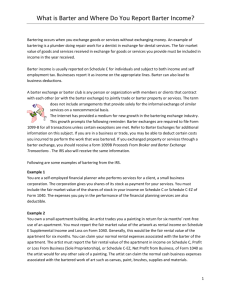Economic Systems
advertisement
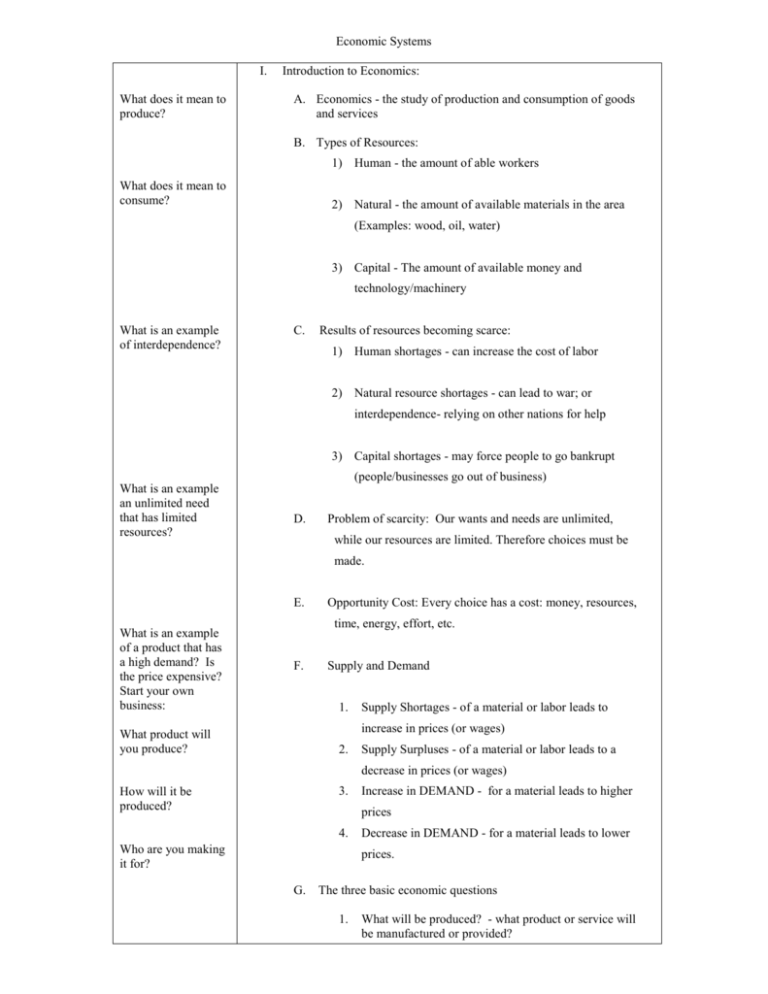
Economic Systems I. What does it mean to produce? Introduction to Economics: A. Economics - the study of production and consumption of goods and services B. Types of Resources: 1) Human - the amount of able workers What does it mean to consume? 2) Natural - the amount of available materials in the area (Examples: wood, oil, water) 3) Capital - The amount of available money and technology/machinery What is an example of interdependence? C. Results of resources becoming scarce: 1) Human shortages - can increase the cost of labor 2) Natural resource shortages - can lead to war; or interdependence- relying on other nations for help 3) Capital shortages - may force people to go bankrupt (people/businesses go out of business) What is an example an unlimited need that has limited resources? D. Problem of scarcity: Our wants and needs are unlimited, while our resources are limited. Therefore choices must be made. E. What is an example of a product that has a high demand? Is the price expensive? Start your own business: Opportunity Cost: Every choice has a cost: money, resources, time, energy, effort, etc. F. Supply and Demand 1. Supply Shortages - of a material or labor leads to increase in prices (or wages) What product will you produce? 2. Supply Surpluses - of a material or labor leads to a decrease in prices (or wages) 3. How will it be produced? Increase in DEMAND - for a material leads to higher prices 4. Who are you making it for? Decrease in DEMAND - for a material leads to lower prices. G. The three basic economic questions 1. What will be produced? - what product or service will be manufactured or provided? 2. How will it be produced? – How will it be manufactured or provided? 3. For whom will it be produced? - What market are you selling to? What problems do barter systems face? II. Types of Economic Systems: A. What are the advantages of the money system B. C. What resources are necessary for survival? Earliest Economic Systems used the barter system 1. Barter System - Goods/services of equal value were traded 2. Money Systems - not yet invented Hunter/gatherer - people that had to rely on nature to survive. 1. Nomads - members of a group of people with no fixed home, who traveled constantly to find food and water because of limited resources 2. Small populations – Human populations were small (25-100 people) due to scarcity of food Traditional economy - economy based on customs and past practices. 1. Agrarian societies - developed as the human population grew a more sophisticated economy 2. Money System - Societies transitioned from a barter system to the use of Money as a ‘medium of exchange’ 3. Agrarian - a society based on farming. Manufacturing is NOT done on a large scale. a. D. What’s produced – basic needs How’s is it producedself-sufficiency and feudal obligations Barter System used as farmers traded their extra crops or livestock for products or services they required Manorialism - the economic portion of feudalism during the Middle Ages (500 – 1400 CE) (develops out of the necessity of survival) 1. Manorialism - Warfare made trade almost impossible, so the manor produced nearly everything that was needed. 2. For whom? – everyone on the manor Self-sufficient - Manors produced everything for surviving (food and clothes from crops and animals) 3. Fief - Each manor included pastures for livestock, fields for crops, forest areas, and a village where the peasants lived 4. Feudal Obligations - Nobles provided protection for the peasants and serfs. In return for the lord’s protection, the peasants provided various services for the lord 1. Peasant Responsibilities: a. Farm b. Repaired roads and bridges c. Provide services as payment – Example: If peasants used the Lord’s oven to bake bread, peasant must leave a loaf or two as payment. d. Blacksmiths, carpenters, shoemakers, miller and vintner all lived in this setting. E. Why do people get loans from banks today? The Commercial Revolution - Time period after the Crusades that brought new economic ideas and practices to Europe with rise of capitalism (private ownership and capital investment) 1. Capital Investment - Raising money was a problem for overseas trading: costs of ships, crew, and goods was extremely high 2. Banks and Loans - Merchants started to turn toward bankers for money – loans 3. Partnerships - New methods of investing $$ came about, as people joined forces to increase the flow of wealth and to reduce the risks of business. 4. Joint stock companies - Individual merchants who wanted to invest in exploration often raised money by combining their resources in organizations that sold stock, to enable small investors to share in the profits. If loss occurred, the investor only lost amount invested Why must people be careful about obtaining loans? a. In mercantilism, what equals power? 5. In mercantilism, who benefits? Dutch East India Company - was a powerful joint stock company. It had the power to make war, seize foreign ships, coin money, and establish colonies and forts. (Part of the mercantile system) Profit - drove this entire movement (Money made after investment) 6. F. G. What is a potential problem with Laissez faire economics? May be chaotic Middle Class – A new social class emerged through new business opportunities (social mobility) Mercantilism - Economic system in Europe during the 16th and 18th centuries whose goal was to gain a favorable balance of trade with its colonies to gain as much wealth as possible. (wealth=power) 1. Nations competed for new markets during the Age of Exploration 2. Wealth came from the raw materials collected from colonies by mother country - Mother country benefits 3. Colonies served as a source of raw materials, as well as vital markets for finished goods 4. Nations sought to create a favorable balance of trade by exporting more goods than they imported! Industrial Revolution – A major change in the way goods were produced through the use of machines, capital, and the centralization of work forces in factories. 1. The origins - The Industrial Revolution began in England during the 1750's 2. Why did the Industrial Rev start in England? 3. a. Rich in natural resources – England was rich in natural resources such as coal, iron b. Irregular Coastlines – British Isles were rich in natural harbors which allowed for easy docking of ships c. Infrastructure – England developed a capable infrastructure that included canals, bridges and roads (Railroads) d. Capital – England had large amounts of money to invest (mercantile system) e. Strong Navy – England had an excellent navy and was able to expanded its colonial empire (increasing its ability to obtain natural resources and reach foreign markets) f. Government - England had a stable and supportive government (Make a lot of $$$) g. Enclosure Movement – This law forced small farmers off land, and they moved to the cities when they became homeless. The increase in population of the cities created a surplus of labor. (Urbanization, influence work conditions) Adam Smith – The Wealth of Nations (1776) becomes the economic philosophy of the age. (Supports free market and Capitalism) Workers rights are not upheld Unsafe working conditions In our current economy, does the government get involved in economic affairs? Explain. 4. They regulate business to ensure productivity and to uphold rights of employees a. Philosophy - Businesses are much more efficient in the use of resources than governments b. Laissez faire - As a result, government should not interfere or regulate business activity (hands off) : Results or Changes in Society a. Industrialization - Large-scale industry or factories (Mass production of goods) through the use of steam powered machines. b. Efficiency and price - Machine From handmade goods to machine made goods - faster & cheaper process c. Factories - From production at home (domestic system) to production in factories d. Mass Production - From producing small amounts to mass production e. Technology - The increased use of science and new forms of energy (steam power) to speed up production. (New technology) f. Urbanization - People move from rural (country) areas to urban area (city) g. Conditions for workers: 1. Long hours (16-18 a day) 2. Low pay (maybe $.03-.04 an hr.) 3. Unsafe working conditions 4. Child labor 5. Overcrowding of cities - unsanitary and diseases H. Why do socialism and Communism have appeal to people? People want equality Socialism: The belief that the means of productioncapital, land, raw materials, and factories - should be owned and controlled by society (Socialism = sharing) 1. Not everyone in Europe agreed with the capitalist way of thinking in the early 1800s. Some people believed that ending the misery of workers required eliminating capitalism completely 2. Karl Marx - The Communist Manifesto (1848) a. Revolutions - Believed that economics was the major force of change Who are the “haves” of today? Government Corporations Who are the havenots” of today? Working class (lower and middle class) I. b. Haves VS. the Have-Nots - The most important aspect of the economic base was the division of society into classes and conflict between classes was inevitable c. Bourgeoisie (Owners) “Haves”- The social class that controlled production and became the new ruling class d. Proletariat – (Workers) “Have-Nots”- The social class that Marx considered the “new” slave or serf e. Communism - Marx’s socialist idea was background for Communism. Marx believed that the Proletariat would overthrow the Bourgeoisie. This revolution would result in a dictatorship that would produce in a classless society through a command economy. He believed that only through this form of government, a socialist society would emerge. Communism (Soviet Union) Russia 1. Bolshevik Revolution - Lenin and the Bolsheviks overthrew the Russian Czar in a bloody revolution in 1918, setting up the USSR. 2. Nationalization - Government carried a policy that brought all major industries under state control 3. Stalin Totalitarian rule – Josef Stalin takes over the USSR after Lenin and begins new economic policies. 4. Command Economy - An economy that is planned and controlled by a central administration 5. Look at the chart below. In considering the current US economy, answer the following question. Is the United States a Market/Capitalist economy or a Command economy? Explain your answer. Five Year Plan –Stalin begins his five year plan to increase the amount of industrialization in the USSR under any circumstances (Set quotas, and those who do not meet quotas are jailed or killed) 6. Collectivization - a system of farming in which the government seized the land from the farmers and then used them to work the land 7. Death to Millions - While initially appealing to the common man, Communism proved to be a heavily flawed political system, and Command Economies were notoriously inefficient as an economic system and often resulted in the deaths of millions through executions and famine. A Comparison of Market & Command Economies Market Economy Command Economy Ownership Private ownership of all property and means of production Government control of all property and means of production Economic Controls Little public control; private citizens and business makes decisions. Government makes all economic decisions Market Forces Supply and demand control prices, promotes competition. Government planning of entire economy. Focuses on industrial goods People make decisions Democracies Government Totalitarian – Communist
